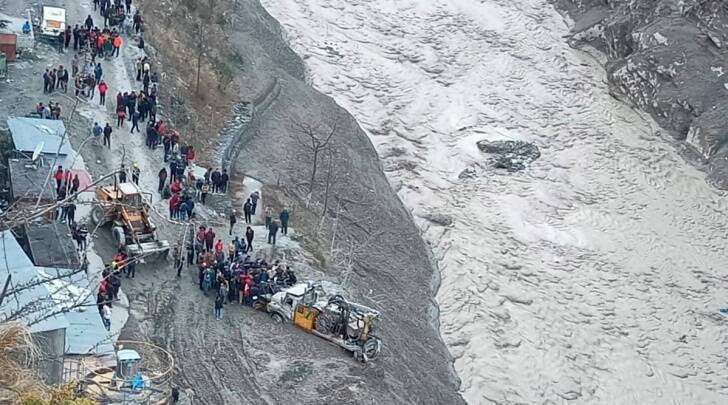We will look at 3 extreme weather events that occurred in the past decade and of significant importance that requires addressing climate concerns
Floods in Sikkim State (12 October 2023):
A major Glacial Lake Outburst Flood occurred from South Lhonak, Sikkim, resulting in the collapse of the Teesta III hydroelectric dam and downstream impacts
The Sikkim floods that occurred on October 12, 2023 were a result of a combination of climatic factors. Here’s what contributed to this devastating event:
- Unusually Heavy Rainfall:
- In early October 2023, a cloudburst caused Sikkim to receive more than double its normal rainfall.
- Glacial Lake Outburst Flood (GLOF):
- The primary factor contributing to the sudden surge appears to be the emergence of a glacial lake outburst flood originating from the South Lhonak glacial lake.
- The South Lhonak lake, located in Sikkim, is a moraine-dammed lake fed by the meltwater of the Lhonak glacier.
- Over the years, as the glacier retreated, the lake swelled in size, covering nearly 100 hectares by 2008.
- In 2018, pipelines were installed to pump water out of the lake due to the risk of glacial outburst floods.
- Dam Destruction:
- The flood reached the Teesta III Dam at Chungthang at midnight.
- Before its gates could be opened, the flood destroyed the dam in minutes.
- Water levels downstream in the River Teesta rose by up to 20 feet (6.1 meters), causing widespread damage.
- Climate Change Implications:
- Climate change likely played a role, as it is melting glaciers and increasing the risk of glacial lake outbursts.
The 2023 Sikkim floods were a tragic event with significant loss of life and property. Efforts to understand and mitigate such disasters are crucial for the safety and well-being of communities in vulnerable regions.
Floods in Odisha State (31 August 2022):
Heavy monsoon rains causing overflowing rivers and landslides affected over 950,000 people in Odisha
The 2022 Odisha floods were a series of devastating floods that occurred in Odisha, lasting from August 14, 2022, to September 7, 2022. These floods had significant impacts on the state, affecting both human lives and property.
Here are the climatic causes that contributed to these floods:
- Extensive Rains:
- The main trigger for the floods was intense and prolonged rainfall.
- Starting from the 3rd week of August 2022, Odisha experienced heavy rains due to the formation of three depression systems over the Bay of Bengal during that month.
- These depression systems brought copious amounts of moisture-laden air, leading to widespread precipitation across the state.
- The combination of monsoonal moisture and the depression systems intensified the rainfall, causing rivers to swell and overflow.
- Long-Term Causes: Beyond the immediate climatic factors, there are long-term causes that contribute to flooding in Odisha:
- Extensive erosion: The state faces erosion of riverbanks and embankments, which weakens their ability to contain floodwaters.
- Unpredictable rainfall: Variability in monsoon patterns and irregular rainfall events impact flood risk
- Improper maintenance of river embankments: Inadequate upkeep of protective structures exacerbates flooding.
- Excessive dam construction: Building dams on rivers without proper planning can alter water flow and increase flood risk.
- Un periodic release of river water from dams: Inconsistent water releases from dams can lead to sudden surges downstream.
The 2022 Odisha floods were a result of a combination of intense rainfall events, monsoon dynamics, and underlying vulnerabilities in the state’s water management systems. Efforts to address both short-term and long-term causes are essential for disaster preparedness and mitigation in flood-prone regions like Odisha.
Cyclone Yaas (03 June 2021):
Cyclone Yaas, which struck India and Bangladesh in late May 2021, had several climatic causes that contributed to its formation and impact:
Formation and Intensification:
- Yaas originated from a tropical disturbance that the Indian Meteorological Department first monitored on May 23, 2021.
- Favorable conditions in the Bay of Bengal allowed it to intensify into a cyclonic storm on the next day, receiving the name Yaas.
- Despite moderate wind shear, Yaas further intensified into a severe cyclonic storm on May 24.
- As it accelerated northeastward, it strengthened to a Category 1-equivalent tropical cyclone and eventually became a very severe cyclonic storm on May 25.
Landfall and Impact:
On May 26, Yaas made landfall on the northern coast of Odisha, approximately 20 km south of Balasore, at its peak intensity as a very severe cyclonic storm.
- The storm brought significant impacts to West Bengal as well.
- Railway operations, marine activities, and rescue authorities were affected, and medical teams were deployed for emergencies.
- In Bangladesh, over two million individuals were evacuated from coastal areas due to the storm’s approach.
- A total of 20 people across India and Bangladesh lost their lives due to Yaas.
Damage and Losses:
West Bengal suffered the most significant impact, with an estimated loss of ₹210 billion (US$2.89 billion).
Odisha also experienced losses, amounting to ₹6.1 billion (US$83.9 million).
Climate Change Implications:
Cyclones in the Bay of Bengal are common during this time of year, but experts note that they are becoming more severe in conjunction with global warming.
High sea temperatures in the warm Bay of Bengal are also a major factor contributing to strong cyclones.
Perigean Spring Tide:
The storm coincided with a perigean spring tide, which is an especially high tide caused by the Moon and Sun being slightly closer to Earth than usual.
As Yaas’s storm surge inundated low-lying coastal areas, heavy rains compounded the impact.
Cyclone Yaas was a powerful and damaging tropical cyclone fueled by favorable climatic conditions, sea surface temperatures, and the specific timing of its occurrence. Efforts to understand and mitigate such cyclones are crucial in the face of changing climate patterns.
Other GLOFs
Several other GLOFs have occurred in India
Kedarnath Disaster (2013):
In 2013, a devastating GLOF occurred in Kedarnath, Uttarakhand.
- The disaster was caused by a combination of cloud outbursts and ice/rock avalanches.
- It claimed thousands of lives and caused substantial socio-economic losses
Chorabari Glacier (2013):
- The Chorabari glacier in Uttarakhand melted, causing a catastrophic GLOF.
- The Kedarnath village was severely affected, resulting in a death toll of more than 5,000 people.
Gaya Glacier (2014):
Chamoli Disaster (2021):
- In 2021, another significant GLOF struck Chamoli district in Uttarakhand.
- The event was triggered by an ice/rock avalanche.
- It resulted in loss of life and extensive damage to the region




